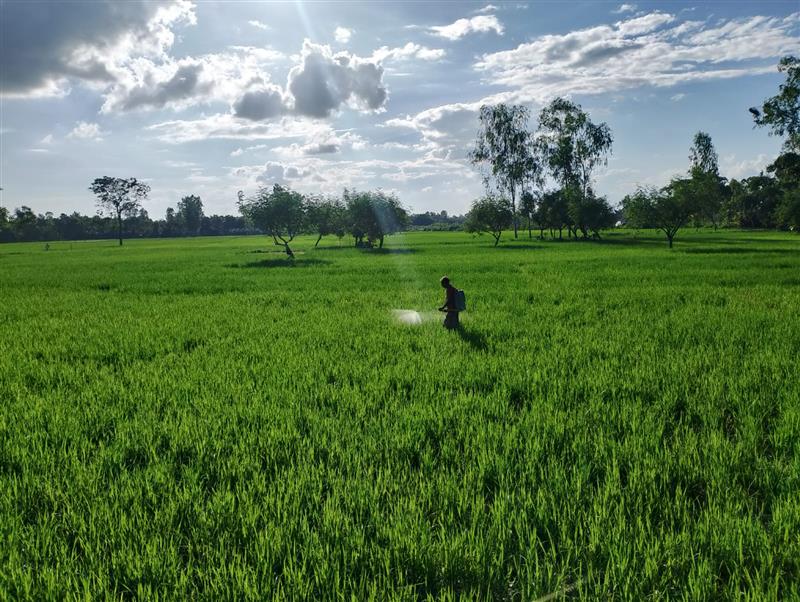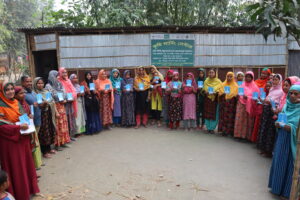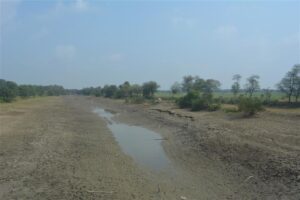By Bushra Humaira Sadaf

A team of researchers from the Bangladesh Rice Research Institute (BRRI), International Rice Research Institute (IRRI), International Fertilizer Development Center (IFDC), and Japan’s National Agriculture and Food Research Organization (NARO) has identified practical strategies to cut greenhouse gas emissions from rice fields without sacrificing yield, conducted across saline and non-saline regions of Bangladesh over consecutive rice seasons. The findings demonstrate that a combination of low-emission varieties and efficient nitrogen management can promote sustainable, climate-resilient rice cultivation across diverse environments.
Greenhouse gas (GHG) emissions from rice paddies are a significant contributor to climate change. A new multi-location study in Bangladesh identifies practical, on-farm strategies using specific rice varieties and optimized nitrogen management to significantly reduce global warming potential without sacrificing crop yield.
Rice cultivation is a major global agricultural activity, but the flooded conditions in rice paddies create a perfect environment for generating methane (CH4 ). Methane is a particularly potent greenhouse gas, significantly more potent at trapping heat than carbon dioxide over a 100-year period. Nitrous oxide (N2 O), another powerful GHG, is also emitted, often due to excessive nitrogen fertilizer application. This research sought to find “climate-smart” practices that could lower these emissions while ensuring food security.
Key mitigation strategies and findings
A new study offers promising insights into how smarter choices in rice varieties and fertilizer use can make cultivation more climate-friendly without hurting yields.
Researchers conducted large scale field trials in both non-saline soils and coastal saline soils over two rice seasons, Boro (dry) and Aman (wet) in Bangladesh, to examine how different rice cultivars and nitrogen fertilizer rates affect greenhouse gas emissions and yields.
Cultivar selection
The study found that selecting the right rice variety is one of the most effective ways to lower methane emissions:
During Boro (Dry) season, the cultivars BRRI dhan67 and BRRI hybrid dhan3 were found to be “climate-smart” choices. BRRI dhan67 reduced CH4 emissions by 9–14% compared to other varieties like BRRI dhan50 and BRRI dhan92. BRRI hybrid dhan3 also notably reduced emissions by 6–14% compared to other varieties.
Similarly, during Aman (Wet) season BRRI dhan75 and BRRI hybrid dhan6 reduced CH4 emissions by approximately 7–14% compared to BRRI dhan87 and BRRI dhan90..
The overall Global Warming Potential (GWP), a single metric for all GHGs, was reduced by 10–13% with BRRI dhan67 and 8–11% with BRRI hybrid dhan3 in the Boro season, demonstrating their strong potential for climate mitigation.
Optimized nitrogen management
Reducing nitrogen fertilizer application by 20% from the recommended rate lowered methane emissions by 6% and nitrous oxide emissions by 17%, without affecting grain yield. This shows that farmers can save input costs while helping reduce the carbon footprint of rice production.
The role of saline soil
Coastal saline soils, which cover a significant area of Bangladesh’s cultivable land, were also evaluated for their impact on emissions. Coastal saline soil was found to significantly reduce the overall GWP by 9% compared to non-saline soil. It also emitted about 10% less CH4 . This is largely due to the microbial inhibition under high salt concentrations, which slows down the process of methanogenesis. However, non-saline soils proved to be better for crop productivity, resulting in 11% more yield and 13% higher total nitrogen uptake compared to the coastal saline soils. These insights underscore how site-specific management can optimize both productivity and environmental outcomes.
Toward low-emission rice systems
The study highlights that integrating optimized nitrogen management with climate-smart rice cultivars can make a significant impact on reducing GHG emissions from rice fields. Such approaches are vital for Bangladesh, where rice covers 75% of agricultural land, and for other delta regions striving to balance food security with climate action.
As global discussions on climate change intensify, findings like these provide actionable pathways for countries to advance sustainable, low-emission rice production.
Read the study:
S.M. Mofijul Islam, Yam Kanta Gaihre, Mohammad Nazrul Islam, Tamal Patra Suvo, Bjoern Ole Sander, Muhammad Ashraful Habib, Aminul Islam, Swati Nayak, Upendra Singh, Toshihiro Hasegawa, Md. Rafiqul Islam
Reducing greenhouse gas emissions and improving rice yield: The influence of cultivars, soil salinity, and nitrogen management
Science of The Total Environment, Volume 997, 2025, 180192, ISSN 0048-9697
https://www.sciencedirect.com/science/article/pii/S0048969725018327






